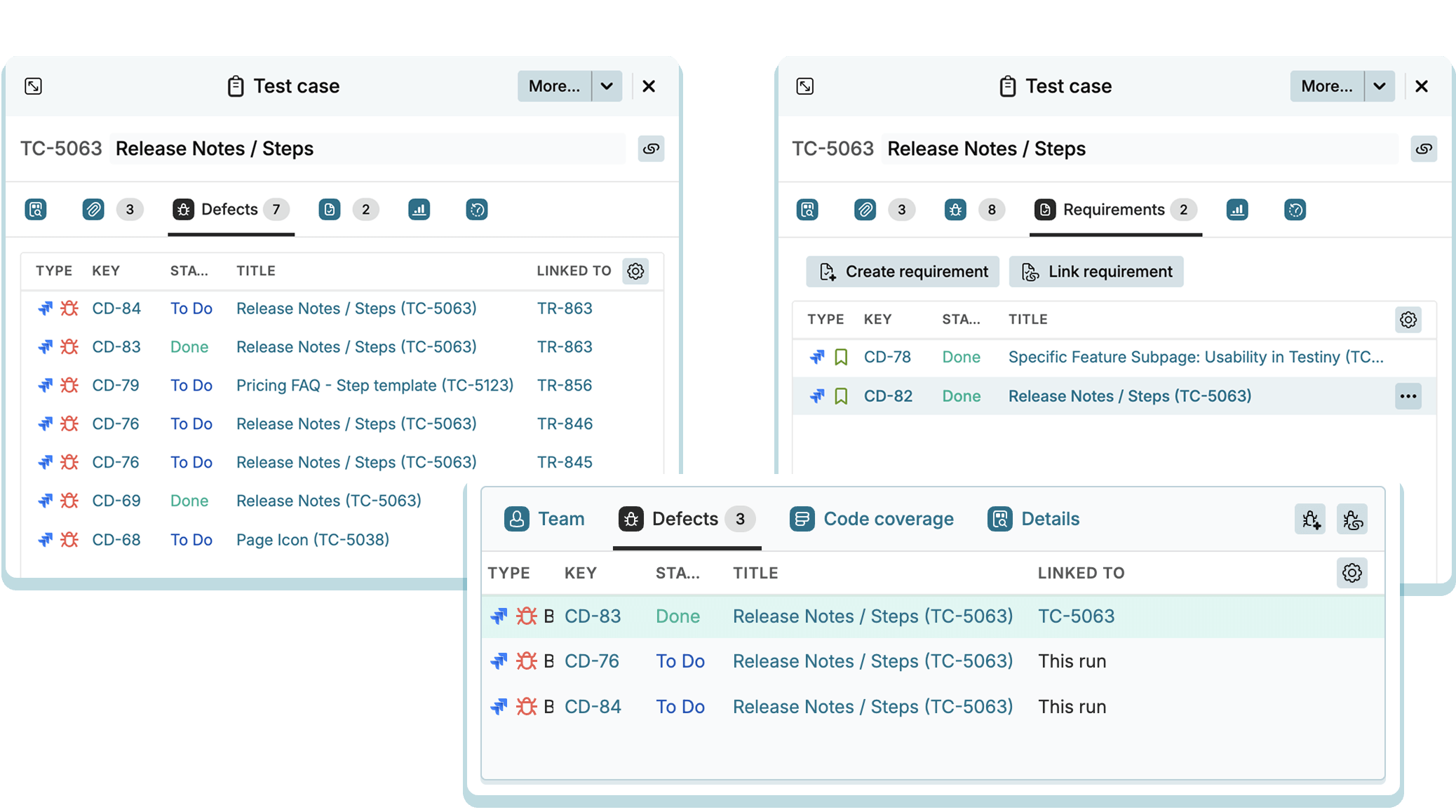GitHub Issues
Use Testiny as your GitHub test management tool and connect test cases and results to GitHub Issues. Testiny fully integrates into both GitHub and GitHub Enterprise Server — you can create, link and look up GitHub issues from Testiny. Testiny makes complex issue-type configuration (with all its custom fields etc.) unnecessary. Testiny reads your issue configurations and performs the whole configuration in the background. Just link Testiny with your GitHub organization — and you’re done!
Do you want to integrate Testiny with GitHub Actions? Learn how to submit automated tests from GitHub Actions to Testiny.
Configuration
To configure a new integration, you need to have admin rights in Testiny.
- Go to Settings > Integrations.
- Click on '
Add integration' for GitHub. A side panel opens where you need to define the following options for the connection:
-
GitHub Organization URL
Enter the URL to your GitHub or GitHub Enterprise Server organization, e.g.https://github.com/myorgorhttps://<your-github-server>/myorg. -
Personal Access Token (PAT) Create a personal access token for your GitHub organization and copy it into this field. We recommend creating a fine-grained personal access token using minimal permissions (limit the access token to the repositories you want to integrate and only set the permissions "Read" or "Read & Write" for "Issues").
- Click the button "Test connection" to check if the credentials are valid and a connection to GitHub can be established.
- When you’ve successfully connected Testiny with GitHub, you can now configure the mapping of the projects. Go to the "Projects" tab to define the scope of the integration:
-
Testiny Projects
-
All projects
By default, the integration is configured for all existing and future projects of your Testiny organization.
You can also choose whether to use this integration for defects only, requirements only, or both.
-
Only specific projects If you want to configure an integration for specific Testiny projects only, select this option. Now you can select for which projects you want to enable this integration.
You can also choose whether to use this integration for defects only, requirements only, or both.
-
-
GitHub repositories
-
All repositories
By default, the integration is configured for all repositories.
-
Only specific repositories
If you want to configure an integration for specific repositories only, select this option. Now you can select which repositories you want to enable this integration for.
-
Using the GitHub Integration
The integration with GitHub allows users to create and link issues in GitHub from Testiny. Issues can be created or linked to test cases, test runs and test results and can be viewed in Testiny.
Creating or linking GitHub Issues
Within Testiny, you can link test runs and executions to GitHub issues. If you find a bug during your tests, you can create an issue in GitHub directly from Testiny. It is also possible to link requirements in GitHub to test cases or create requirements in GitHub directly from Testiny to build up your test coverage matrix.
GitHub issues can be created (or linked to) in Testiny from the following entities:
-
Test cases
It is possible to link requirements to test cases (a requirement can be any type of GitHub issue)or to create a requirement that is automatically linked to the test case.
-
Test runs and test executions
Testiny provides the ability to create defects(or link an existing issue) directly from a test run or a test execution.

Creating issues
When creating a requirement or a defect from Testiny, a create dialog will open where you can set the fields for the GitHub issue. In this dialog you can select the GitHub project, the issue type and set any other fields that may be required. Click Create to confirm. If pop-ups are allowed, the newly created issue will open in a new browser tab. Otherwise, a small window with the details and a link to the issue will appear.
Depending on your configuration and the integration’s requirements, you can select
- a project via dropdown
- issue type via dropdown
- any relevant custom fields via multi-select (optional)
You can also choose to Add test steps to description, and if there are comments on the test case, an option to Add comments to description will appear.
Linking existing issues
When linking a requirement or a defect, a search dialog will open where you can search all existing issues directly in Testiny (no need to switch to GitHub) and select the issue you want to link.
Currently, we do not support creating items/issues in GitHub projects and setting custom item fields. The GitHub integration in Testiny can link and create repository issues only.
Use the Select fields dropdown to add any fields available through the external integration.
Accessing GitHub Issues in Testiny
Connecting GitHub with Testiny allows you to directly look up and access GitHub issues.
Testiny shows essential information such as the issue status or the issue type inline.
Essential information like the issue title or issue status is synchronized into Testiny.
This means that even if the integration is unavailable, Testiny remains unaffected and will still display the synchronized data.
For further details on linked issues, the issue can be opened directly from Testiny by clicking the issue ID. Testiny supports issue links in various places:
- Test cases
- Test runs
- Test results
- Milestones
